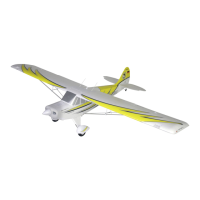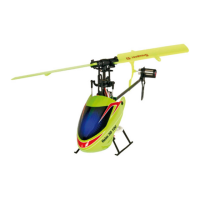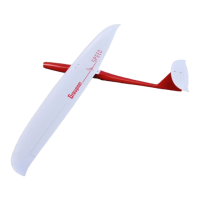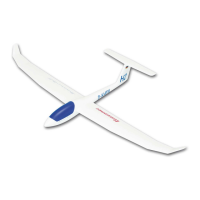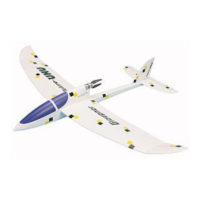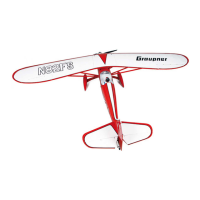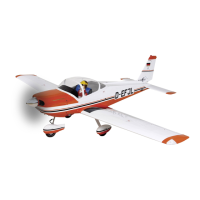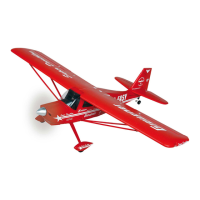GRAUPNER GmbH & Co. KG D-73230 KIRCHHEIM/TECK GERMANY
Änderungen vorbehalten! Keine Haftung für Druckfehler! Ident-Nr. 0057999
Made in Thailand
04/2003
76
76
− Connect the retract units as described in the instructions supplied with the set, and deploy the air lines in
such a way that the hoses (especially the brake lines) cannot become kinked when the units are retracted or
extended, or get tangled with other hoses when retracted. Install the self-adhesive retainer plates (No. 33)
and cable ties (No. 34) which support the pressure hoses for the retracts and brakes.
− Alternatively the air lines and cable looms can be secured using soft binding wire (71).
− Tape the brake hoses to the undercarriage legs and run the air hose into the fuselage under the wing skin,
between the outer skin and the retract unit support plate. Allow plenty of excess hose so that there is no
chance of it being placed under strain or becoming kinked (Fig. 3d).
− We recommend running the nosewheel steering cables (No. 46) to the steerable noseleg unit at this stage,
i.e. before you install the unit (Figs. 3e, 14).
− If you are using the original valves from Order No. 174 or 175, screw the two valves to the valve plate (No.
24) using the screws and nuts (No. 36 / 37); alternatively thick cyano can be used to secure them. The
servos (C 261 shown) can be fixed in place using thick cyano (Figs. 4, 4a, 4b, 4c, 17, 17a, 17b).
− Attach the prepared valve plate (No. 24) to the right-hand longitudinal member at the front of the fuselage
using the fixings (No. 38, 39, 40), as shown in (Figs. 4, 17c).
− Pack the retract system air tank in foam, and install it in the fuselage nose, forward of the retract unit
bulkhead (Fig. 18).
− If you prefer to use digital control valves (two valves are required), fix them to a piece of plywood (not
included in the kit) (Fig. 4d) and glue it in the front part of the fuselage in the same position as the
mechanical valves, as shown in (Figs. 4, 6a, 17c).
− Fix the Servo-Lock (No. 41) to the floor former (No. 23) using the self-tapping screws (No. 42) (Fig. 13),
then glue the former / servo assembly to the bottom of the fuselage using UHU plus endfest 300 as shown
in (Figs. 5a, 15), with the relieved side flush with the cut-out in the steerable noseleg unit.
− Make up the linkage at the servo end from parts (No. 43, 44, 45, 46, 47) (Figs. 5s, 5a, 5b, 14, 15). The
steering cables for the steerable noseleg unit are passed through short pieces of brass sleeve (No. 45); the
ends can either be soldered or simply crimped.
− Bend the steel rod (No. 49) to the approximate shape shown in (Fig. 16), and attach it to the noseleg unit
bulkhead using the self-tapping screw (No. 50) (Fig. 16a).
− Connect the formed rod (No. 49) and the rubber band to the steering cables (No. 46) of the steerable
noseleg, so that the cables are pulled upward when the noseleg unit is retracted.
− When the retractable undercarriage is completely installed and working, carry out a comprehensive check
of the system.
− Be sure to read through the instructions supplied with the retract system several times, taking particular
note of the instructions regarding methods of working and maintenance.
Canopy
− Since the canopy frame and the complete frame retainer system is prepared and installed at the factory (Fig.
25), all that remains is to cut out the canopy moulding and trim it to fit accurately.
− Cut out the canopy, leaving it oversize initially, place it under the frame and mark the exact line of the
periphery. Remove the canopy and trim it to final size (Fig. 24).
− Glue the canopy to the canopy frame; we recommend UHU Por contact cement for this.
−
Thrust vectoring pipe, pivot bearings
− Mark the position of the pivot axis of the thrust vectoring pipe as shown in (Figs. 10, 38) using a pencil and
ruler. Hold the ruler above and below the turbine support plate to mark this point. Set slide callipers to 22
mm and use them to score the fuselage lightly in the area of the pencil marks, working through the fuselage
opening from the rear (Figs. 10a, 38a).
− Push a stout pin through the inside of the fuselage at the marked points.
− Open up the holes to 4 mm Ø, working from the outside (Fig. 38).
− Prepare the pivot bearing discs (No. 8) (laminate, chamfer edges - Fig. 38c), position them over the holes
and tack them in place with cyano (Figs. 10b, 38d). Reinforce the joints with thickened epoxy resin and
glass cloth (Figs. 10e, 38e). Fit a suitable length of 4 mm Ø round rod through both discs to align them
accurately.
− Attach the aluminium bearing components (9) to the thrust vectoring pipe using the screws (No. 10), and
secure the screws with thread-lock fluid (Figs. 11, 39a, 39b).
− Screw the ball-link (No. 60) to the thrust vectoring pipe actuating lug and secure it with the M2 self-locking
nut (No. 61) (Figs. 11a, 39b).
− Install the thrust vectoring pipe in the pivot system, and secure it from the outside using M3 x 8 screws
(No. 10), as described above. You may need to countersink the outside skin of the fuselage to provide
freedom of movement (Figs. 11b, 39c, 39d).
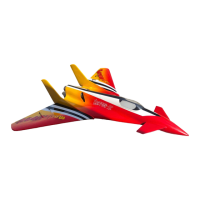
